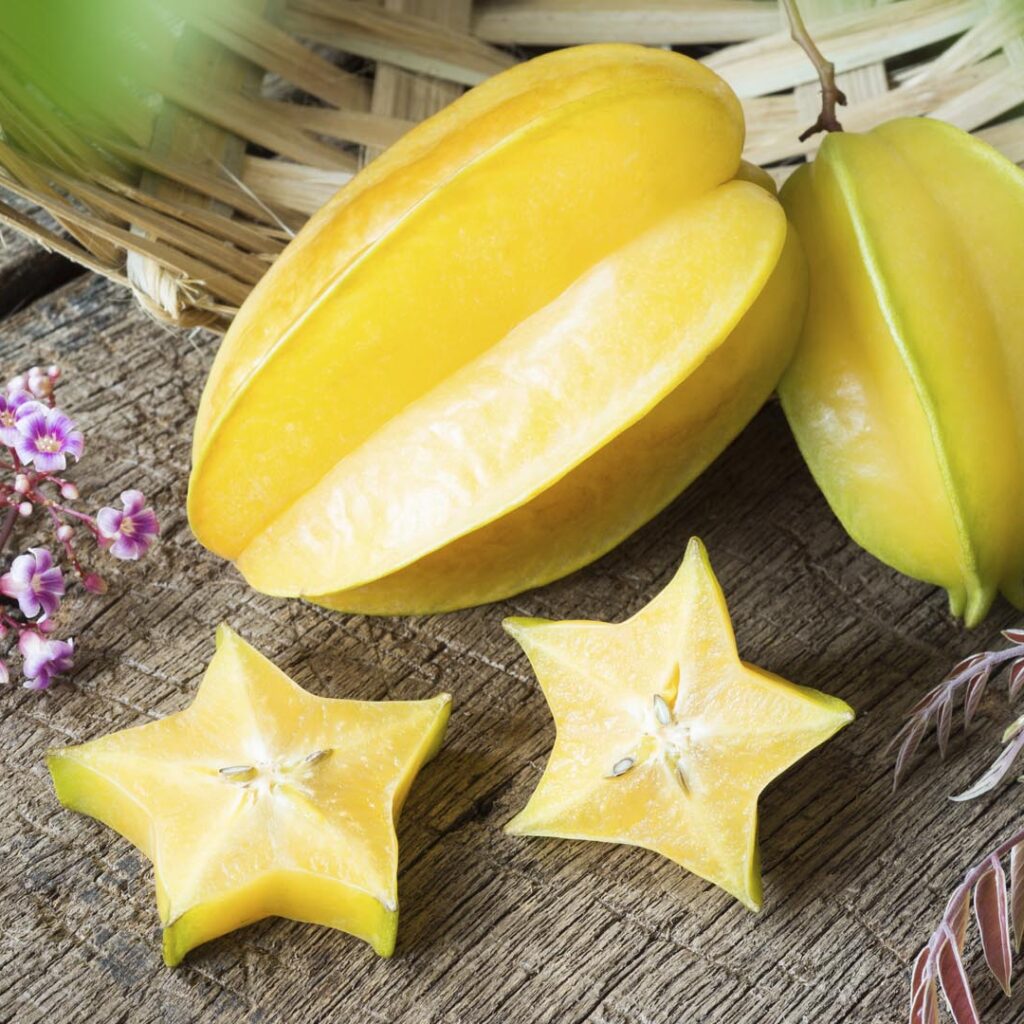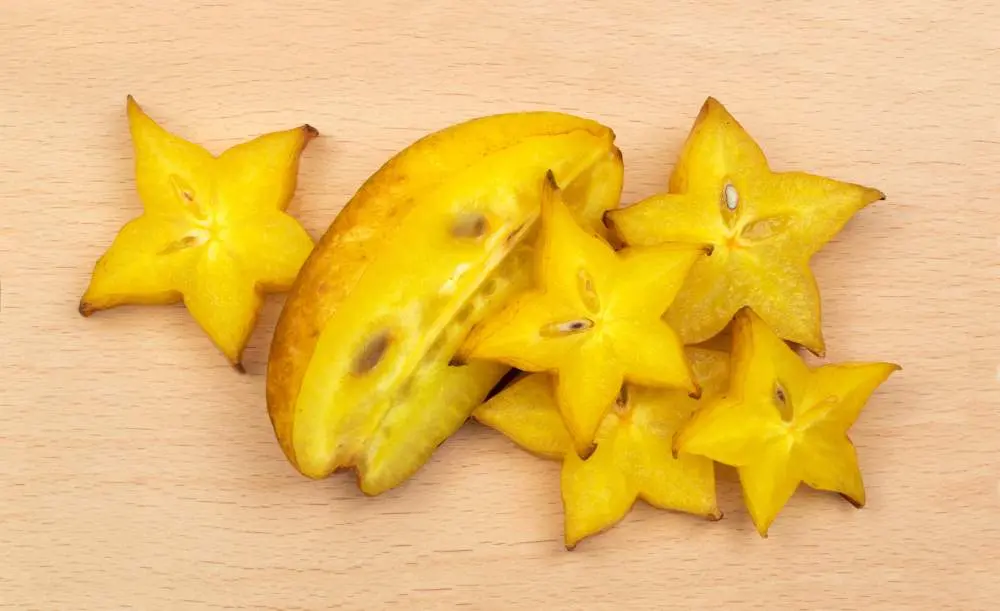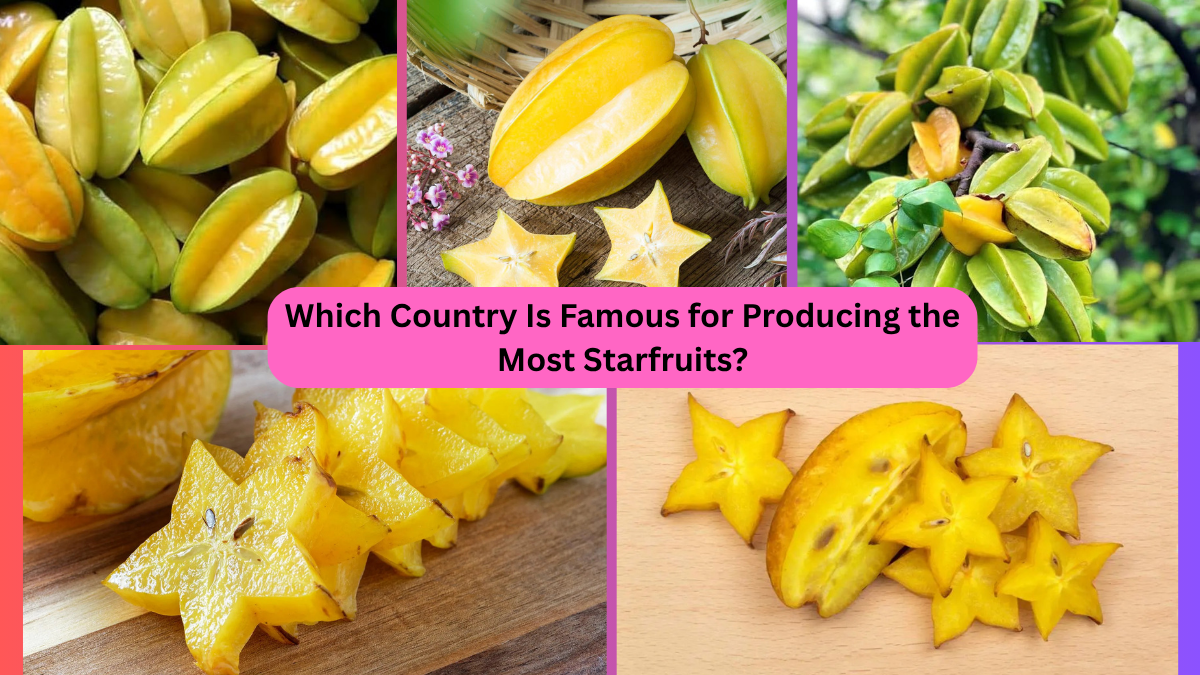The starfruit, known for its unique star-shaped cross-section and crisp, sweet-tart flavor, is one of the most exotic and visually captivating fruits in the world. Officially called carambola (Averrhoa carambola), this tropical fruit has not only charmed food lovers but also become a staple in international markets, health food menus, and culinary shows.
But have you ever wondered which country is famous for producing the most starfruits?
In this article, we’ll uncover the origins, global production leaders, and the fascinating journey of starfruit from tropical orchards to fruit baskets worldwide.
What is Starfruit?

Starfruit, or carambola, is a tropical and subtropical fruit native to Southeast Asia. Its distinct five-pointed star shape when sliced, glossy golden-yellow skin, and juicy flesh make it both decorative and delicious.
Flavor Profile:
Starfruit has a crisp, juicy texture with a flavor ranging from sweet to tangy, depending on the variety and ripeness. It’s often enjoyed fresh, juiced, or as a garnish in fruit salads, desserts, and tropical drinks.
Nutritional Value:
Low in calories but rich in vitamin C, antioxidants, and fiber, starfruit is known for its immunity-boosting and digestion-aiding properties.
A Brief History of Starfruit
Starfruit originated in the tropical regions of Southeast Asia, particularly Malaysia, Indonesia, and the Philippines. It has been cultivated for centuries in this region before gradually spreading to India, China, Australia, and the Caribbean.
Today, starfruit is grown in several tropical and subtropical areas around the world — but a few countries lead in large-scale production and global export.
Which Country Is Famous for Producing the Most Starfruits?

When it comes to starfruit production, Malaysia stands out as the most famous and prolific country in the world. Thanks to its ideal tropical climate, fertile soil, and centuries-old cultivation tradition, Malaysia has become synonymous with high-quality starfruits in international markets.
Malaysia: The Starfruit Capital of the World
Why Malaysia Leads:
- Native Origin: Starfruit is indigenous to Malaysia, making it naturally adapted to local growing conditions.
- Ideal Climate: The country’s hot, humid, and rainy tropical environment suits starfruit trees perfectly.
- Established Export Industry: Malaysia has long exported premium-grade starfruits to China, Hong Kong, Singapore, the Middle East, and Europe.
- Selective Breeding: Malaysian farmers have developed superior varieties known for larger size, sweeter taste, and longer shelf life.
Malaysia’s Starfruit Production Stats:
- Annual Production: Estimated around 40,000 to 60,000 metric tons.
- Major Growing Regions: Selangor, Perak, Johor, and Negeri Sembilan.
- Top Varieties:
- B10 and B17 (sweet varieties)
- Fwang Tung (tart variety)
Malaysia’s starfruit is especially prized for its deep golden color, firm texture, and balanced flavor — making it a favorite for both fresh consumption and gourmet culinary applications.
Other Major Starfruit Producing Countries

While Malaysia is the world’s starfruit leader, several other tropical countries also produce significant quantities for local and export markets.
Philippines
As one of starfruit’s native homes, the Philippines grows starfruit widely, known locally as “balimbing.”
- Major Regions: Luzon, Visayas, and Mindanao
- Uses: Consumed fresh, pickled, or cooked in local dishes.
Though most production is for domestic consumption, small exports reach neighboring Asian countries and the Middle East.
India
India has embraced starfruit, especially in South India and coastal regions like Kerala and Karnataka.
- Varieties: Both sweet and sour types.
- Uses: Common in juices, salads, chutneys, and as a tangy snack with salt and spices.
Production is largely domestic, with occasional exports to Gulf countries.
Thailand

Thailand is another key producer, growing starfruit in home gardens, orchards, and as a cash crop.
- Famous For: Exporting premium-quality starfruits to China, Hong Kong, and Singapore.
- Varieties: Known for both intensely sweet and sour types.
United States (Florida, Hawaii)
Florida and Hawaii are the primary starfruit-growing regions in the USA.
- Florida’s Market: Supplies domestic markets, especially health food stores and Asian groceries.
- Hawaii’s Market: Sold fresh and incorporated in island cuisine.
The U.S. is also a significant importer of starfruit, particularly from Malaysia and Thailand.
Where Does the World Get Most of Its Starfruits?

While several countries grow starfruit, the bulk of the international commercial supply comes from Malaysia.
Malaysia’s well-developed agricultural infrastructure, advanced post-harvest handling, and strict quality standards have made it the most reliable exporter of fresh starfruits globally.
Malaysia’s Export Markets:
- China
- Hong Kong
- Singapore
- Middle East (UAE, Saudi Arabia, Qatar)
- Europe (United Kingdom, France, Germany)
- Australia
Malaysia accounts for over 50% of global starfruit exports.
Thailand and the Philippines contribute to Asian markets and the Middle East, while the U.S. market is supplied domestically from Florida and Hawaii and through imports from Southeast Asia.
Why Is Starfruit So Popular Worldwide?
Several factors explain starfruit’s growing international demand:
- Exotic Appeal: Its unique star-shaped cross-section makes it visually stunning in culinary presentations.
- Health Benefits: Packed with vitamin C, fiber, antioxidants, and plant compounds beneficial for immunity and digestion.
- Low-Calorie Snack: With only around 30 calories per 100 grams, starfruit is a guilt-free treat.
- Versatility: Eaten raw, juiced, pickled, dried, or used in desserts, smoothies, cocktails, and savory dishes.
Its natural sweet-tart flavor and refreshing crunch make it increasingly popular in health-conscious and plant-based diets.
Challenges in Global Starfruit Production
Despite its rising popularity, starfruit farming faces challenges:
- Climate Sensitivity: Requires warm, humid, and frost-free environments.
- Short Shelf Life: Ripe starfruits spoil quickly, limiting their export range without cold-chain logistics.
- Pest and Disease Management: Vulnerable to fruit flies, leaf blight, and anthracnose in humid conditions.
- Market Fluctuations: Demand spikes seasonally, especially in festive periods like Chinese New Year.
Countries like Malaysia have invested in research farms, modern irrigation, and advanced packaging to overcome these obstacles.
World Starfruit Production Overview (Approximate Figures)
| Rank | Country | Annual Production (Metric Tons) |
|---|---|---|
| 1 | Malaysia | 40,000–60,000 |
| 2 | Philippines | 30,000–40,000 |
| 3 | India | 20,000–30,000 |
| 4 | Thailand | 15,000–25,000 |
| 5 | United States | 8,000–10,000 |
Conclusion: Which Country Is Famous for Producing the Most Starfruits?
When it comes to starfruit production and global fame, Malaysia proudly leads the world.
Its combination of favorable climate, superior cultivation techniques, and established export channels has positioned it as the undisputed starfruit capital.
While other countries like the Philippines, India, and Thailand also contribute to global markets, Malaysia remains the top choice for premium-quality, export-grade starfruits found in gourmet markets and international supermarkets.
As global awareness of tropical superfoods grows, starfruit’s exotic charm and health benefits continue to secure its place in fruit bowls, five-star hotels, and health food stores across the world — with Malaysia at the heart of this fruity revolution.





